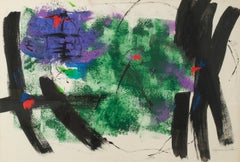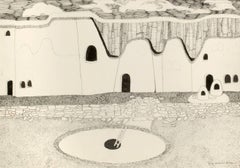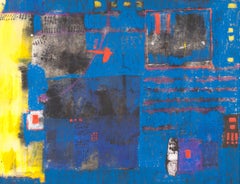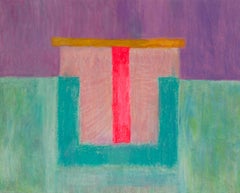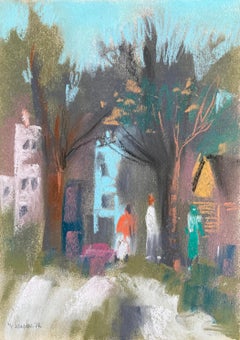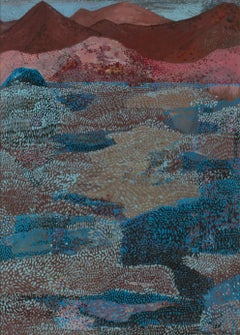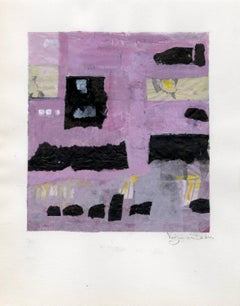Virginia Dehn Drawings and Watercolor Paintings
to
5
5
1
3
1
Overall Height
to
Overall Width
to
3
2
2
2
5
16
706
412
288
228
2
2
2
1
1
Artist: Virginia Dehn
untitled
By Virginia Dehn
Located in Fairlawn, OH
Untitled
Acrylic on paper, c. 1975
Signed by the artist in ink lower right (see photo)
An early Modernist Abstraction, created shortly after the death of her husband, Adolf Dehn in 1968.
Condition: Excellent
Archival framing
Image size: 18 x 24
Provenance: Estate of the artist
Dehn Heirs
Virginia Dehn
From Wikipedia, the free encyclopedia
Virginia Dehn
Virginia Dehn in her studio in Santa Fe
Virginia Dehn (née Engleman) (October 26, 1922 – July 28, 2005) was an American painter and printmaker. Her work was known for its interpretation of natural themes in almost abstract forms. She exhibited in shows and galleries throughout the U.S. Her paintings are included in many public collections.
Life
Dehn was born in Nevada, Missouri on October 26, 1922.] Raised in Hamden, Connecticut, she studied at Stephens College in Columbia, Missouri before moving to New York City. She met the artist Adolf Dehn while working at the Art Students League. They married in November 1947. The two artists worked side by side for many years, part of a group of artists who influenced the history of 20th century American art. Their Chelsea brownstone was a place where artists, writers, and intellectuals often gathered.
Early career
Virginia Dehn studied art at Stephens College in Missouri before continuing her art education at the Traphagen School of Design, and, later, the Art Students League, both located in New York City. In the mid-1940s while working at the Associated American Artists gallery, she met lithographer and watercolorist Adolf Dehn. Adolf was older than Virginia, and he already enjoyed a successful career as an artist. The two were married in 1947 in a private ceremony at Virginia's parents house in Wallingford, Connecticut.
Virginia and Adolf Dehn
The Dehns lived in a Chelsea brownstone on West 21st Street where they worked side by side. They often hosted gatherings of other influential artists and intellectuals of the 20th century. Among their closest friends were sculptor Federico Castellón and his wife Hilda; writer Sidney Alexander and his wife Frances; artists Sally and Milton Avery; Ferol and Bill Smith, also an artist; and Lily and Georges Schreiber, an artist and writer. Bob Steed and his wife Gittel, an anthropologist, were also good friends of the Dehns. According to friend Gretchen Marple Pracht, "Virginia was a glamorous and sophisticated hostess who welcomed visitors to their home and always invited a diverse crowd of guests..." Despite their active social life, the two were disciplined artists, working at their easels nearly daily and taking Saturdays to visit galleries and view new work.
The Dehns made annual trips to France to work on lithographs at the Atelier Desjobert in Paris. Virginia used a bamboo pen to draw directly on the stone for her lithographs, which often depicted trees or still lifes. The Dehns' other travels included visits to Key West, Colorado, Mexico, and countries such as Greece, Haiti, Afghanistan, and India.
Dehn's style of art differend greatly from that of her husband, though the two sometimes exhibited together. A friend of the couple remarked, "Adolf paints landscapes; Virginia paints inscapes." Virginia Dehn generally painted an interior vision based on her feelings for a subject, rather than a literal rendition of it.] Many of her paintings consist of several layers, with earlier layers showing through. She found inspiration in the Abstract Expressionism movement that dominated the New York and Paris art scenes in the 1950s. Some of her favorite artists included Adolf Gottileb, Rothko, William Baziotes, Pomodoro, and Antonio Tapies.
Dehn most often worked with bold, vibrant colors in large formats. Her subjects were not literal, but intuitive. She learned new techniques of lithography from her husband Adolf, and did her own prints. Texture was very important to her in her work. Her art was influenced by a variety of sources. In the late 1960s she came across a book that included photographs of organic patterns of life as revealed under a microscope. These images inspired her to change the direction of some of her paintings. Other influences on Dehn's art came from ancient and traditional arts of various cultures throughout the world, including Persian miniatures, illuminated manuscripts, Dutch still life painting, Asian art, ancient Egyptian artifacts...
Category
20th Century Abstract Virginia Dehn Drawings and Watercolor Paintings
Materials
Acrylic
untitled (Pueblo)
By Virginia Dehn
Located in Fairlawn, OH
Untitled (Taos Pueblo)
Ink on paper, 1985-1990
Signed by the artist in ink lower right (see photo)
An early New Mexico period work, created shortly after the artist moved from New York.
Provenance: estate of the artist
Dehn Heirs
Condition: Excellent
Image/sheet size: 13 1/8 x 18 1/2 inches
Virginia Dehn
From Wikipedia, the free encyclopedia
Virginia Dehn
Virginia Dehn in her studio in Santa Fe
Virginia Dehn (née Engleman) (October 26, 1922 – July 28, 2005) was an American painter and printmaker. Her work was known for its interpretation of natural themes in almost abstract forms. She exhibited in shows and galleries throughout the U.S. Her paintings are included in many public collections.
Life
Dehn was born in Nevada, Missouri on October 26, 1922.] Raised in Hamden, Connecticut, she studied at Stephens College in Columbia, Missouri before moving to New York City. She met the artist Adolf Dehn while working at the Art Students League. They married in November 1947. The two artists worked side by side for many years, part of a group of artists who influenced the history of 20th century American art. Their Chelsea brownstone was a place where artists, writers, and intellectuals often gathered.
Early career
Virginia Dehn studied art at Stephens College in Missouri before continuing her art education at the Traphagen School of Design, and, later, the Art Students League, both located in New York City. In the mid-1940s while working at the Associated American Artists gallery, she met lithographer and watercolorist Adolf Dehn. Adolf was older than Virginia, and he already enjoyed a successful career as an artist. The two were married in 1947 in a private ceremony at Virginia's parents house in Wallingford, Connecticut.
Virginia and Adolf Dehn
The Dehns lived in a Chelsea brownstone on West 21st Street where they worked side by side. They often hosted gatherings of other influential artists and intellectuals of the 20th century. Among their closest friends were sculptor Federico Castellón and his wife Hilda; writer Sidney Alexander and his wife Frances; artists Sally and Milton Avery; Ferol and Bill Smith, also an artist; and Lily and Georges Schreiber, an artist and writer. Bob Steed and his wife Gittel, an anthropologist, were also good friends of the Dehns. According to friend Gretchen Marple Pracht, "Virginia was a glamorous and sophisticated hostess who welcomed visitors to their home and always invited a diverse crowd of guests..." Despite their active social life, the two were disciplined artists, working at their easels nearly daily and taking Saturdays to visit galleries and view new work.
The Dehns made annual trips to France to work on lithographs at the Atelier Desjobert in Paris. Virginia used a bamboo pen to draw directly on the stone for her lithographs, which often depicted trees or still lifes. The Dehns' other travels included visits to Key West, Colorado, Mexico, and countries such as Greece, Haiti, Afghanistan, and India.
Dehn's style of art differend greatly from that of her husband, though the two sometimes exhibited together. A friend of the couple remarked, "Adolf paints landscapes; Virginia paints inscapes." Virginia Dehn generally painted an interior vision based on her feelings for a subject, rather than a literal rendition of it.] Many of her paintings consist of several layers, with earlier layers showing through. She found inspiration in the Abstract Expressionism movement that dominated the New York and Paris art scenes in the 1950s. Some of her favorite artists included Adolf Gottileb, Rothko, William Baziotes, Pomodoro, and Antonio Tapies.
Dehn most often worked with bold, vibrant colors in large formats. Her subjects were not literal, but intuitive. She learned new techniques of lithography from her husband Adolf, and did her own prints. Texture was very important to her in her work. Her art was influenced by a variety of sources. In the late 1960s she came across a book that included photographs of organic patterns of life as revealed under a microscope. These images inspired her to change the direction of some of her paintings. Other influences on Dehn's art came from ancient and traditional arts of various cultures throughout the world, including Persian miniatures, illuminated manuscripts, Dutch still life painting, Asian art, ancient Egyptian artifacts...
Category
Early 20th Century American Modern Virginia Dehn Drawings and Watercolor Paintings
Materials
Ink
Signs
By Virginia Dehn
Located in Fairlawn, OH
Ink and pastel on paper
Signed by the artist in ink lower left; titled in pencil verso
From the Estate of the artist
Category
Mid-20th Century Abstract Virginia Dehn Drawings and Watercolor Paintings
Materials
Pastel
untitled
By Virginia Dehn
Located in Fairlawn, OH
Unsigned
Authenticated verso by the artist's nephew, Andrew Lowe
Provenance:
Estate of the Artist
Category
Mid-20th Century Abstract Expressionist Virginia Dehn Drawings and Watercolor Paintings
Materials
Pastel
untitled (Pueblo)
By Virginia Dehn
Located in Fairlawn, OH
Untitled (Taos Pueblo)
Ink on paper, 1985-1990
Signed by the artist in ink lower right (see photo)
An early New Mexico period work, created shortly af...
Category
Early 20th Century American Modern Virginia Dehn Drawings and Watercolor Paintings
Materials
Ink
Related Items
Ink on Paper Drawing of a Cedar Tree and a Northern Lake by Artist Harold Haydon
By Harold Haydon
Located in Chicago, IL
A 1926 ink on paper drawing of a Cedar tree and northern lake by artist Harold Haydon.
Harold Emerson Haydon was born in Fort William, Ontario, Canada in 1909. Haydon came to Ch...
Category
1920s American Modern Virginia Dehn Drawings and Watercolor Paintings
Materials
Paper, Ink
William Jacobs "Urban Scene II", original pastel on paper
By William Jacobs
Located in Glenview, IL
"Urban Scene II" by noted Chicago painter William Jacobs (1897 - 1973) is a pastel on paper created in 1972. The artwork is signed and dated in pencil by t...
Category
1970s American Modern Virginia Dehn Drawings and Watercolor Paintings
Materials
Pastel
H 5 in W 7 in D 0.01 in
"Untitled" Acrylics, Pencils, Oil Pastels on Paper in Neutral Hues of Taupe
By Karina Gentinetta
Located in New York, NY
"Untitled" 2019, 25" x 31" horizontal drawing on paper by Argentine-born artist Karina Gentinetta (featured in Elle Decor, the New York Times, Tradi...
Category
21st Century and Contemporary Abstract Expressionist Virginia Dehn Drawings and Watercolor Paintings
Materials
Glaze, Oil Pastel, Acrylic, Carbon Pencil
"Frozen Tracks in Snow", contemporary abstract landscape acrylic & crayon, paper
By Mel Reese
Located in Brooklyn, NY
An acrylic and caran d'ache abstract drawing of the moment in the season when it is so crips and quiet that your shoes make clear tracks frozen in the snow.
This drawing was produce...
Category
2010s Abstract Virginia Dehn Drawings and Watercolor Paintings
Materials
Oil Crayon, Acrylic, Archival Paper
Abstract "Tree Landscape" Ink Line Drawing 1981 American Modernist Jack Hooper
By Jack Hooper
Located in Arp, TX
Jack Hooper
"Tree Landscape"
1981
Ink on glossy paper
11"x7" unframed
Signed and dated in pencil lower right
Embrace the serene beauty of nature through this abstract line drawing b...
Category
Mid-20th Century American Modern Virginia Dehn Drawings and Watercolor Paintings
Materials
Paper, Ink
Mercedes Matter, New York School Abstract Figures
By Mercedes Matter
Located in New York, NY
Mercedes Carles Matter (1913 - 2001)
Untitled, circa 1937
Pastel on paper
16 x 13 1/2 inches
Estate stamped on the reverse
Provenance:
Estate of the artist
Spanierman Gallery, New York
Private Collection, Pennsylvania circa 2013
Private Collection, New York, 2021
Mercedes Matter was born in New York in 1913. Her father, the American modernist Arthur B. Carles, had studied with Matisse. Her mother, Mercedes de Cordoba, was a model for Edward Steichen. Ms. Matter grew up in Philadelphia, New York and Europe.
She began painting under her father's supervision at age 6, and studied art at Bennett College in Millbrook, N.Y., and then in New York City with Maurice Sterne, Alexander Archipenko and Hans Hofmann.
In the late 1930's, she was an original member of the American Abstract Artists organization and worked for the federal Works Progress Administration, assisting Fernand Léger on his mural for the French Line passenger ship company. Léger introduced her to Herbert Matter, the Swiss graphic designer and photographer, whom she married in 1939.
The Matters were active in the emerging New York art scene and also traveled frequently to Europe. Their closest friends included Jackson Pollock, Lee Krasner, Franz Kline, Philip Guston, Alexander Calder and Willem de Kooning. They were also close to Alberto Giacometti, who was an important artistic role model for Mrs. Matter and a frequent photographic subject for her husband.
Beginning in 1953, Mrs. Matter taught at the Philadelphia College of Art (now University of the Arts), Pratt Institute and New York University. Based on her teaching experiences she wrote an article for Art News in 1963 titled ''What's Wrong with U.S. Art Schools?'' In it, she lamented the phasing out of the extended studio classes required to initiate ''that painfully slow education of the senses,'' which she considered an artist's life work.
The article prompted a group of Pratt students to ask her to form a school based on her ideas, which led, in 1964, to the founding of the New York Studio School. Originally in a loft on Broadway, the school gained almost immediate support from the Kaplan Fund, the Rockefeller Brothers Fund and the Ford Foundation. It granted no degrees, had only studio classes and emphasized drawing from life. Its teachers, chosen by the students, included the artists Guston, Bradley Walker Tomlin, Charles Cajori, Louis Finkelstein...
Category
1930s Abstract Expressionist Virginia Dehn Drawings and Watercolor Paintings
Materials
Oil Pastel, Paper, Pastel
William Jacobs "Chicago Skyline IV", original pastel on paper
By William Jacobs
Located in Glenview, IL
"Chicago Skyline IV" by noted Chicago painter William Jacobs (1897 - 1973) is a pastel on paper created in 1972. The artwork is signed in pencil by the...
Category
1970s Abstract Virginia Dehn Drawings and Watercolor Paintings
Materials
Pastel
H 5 in W 7 in D 0.01 in
Phyllis Ciment Abstract Pastel Painting c.1970s
By Phyllis Ciment
Located in San Francisco, CA
Phyllis Ciment Abstract Pastel Painting c.1970s
Red, white and blue - Fine colorful abstract painting
24" wide x 18" high
The frame measures 33" wide x 28" high
Signed by the art...
Category
Mid-20th Century Abstract Virginia Dehn Drawings and Watercolor Paintings
Materials
Pastel
Whimsical Fishing Illustration Cartoon 1938 Mt Tremblant Ski Lodge William Steig
By William Steig (b.1907)
Located in Surfside, FL
Lighthearted Illustration of Outdoor Pursuits This one of a fisherman signed "W. Steig"
Provenance: from Mrs. Joseph B. Ryan, Commissioned by Joe Ryan for the bar at his ski resort, Mount Tremblant Lodge, in 1938.
Mont Tremblant, P.Q., Canada
Watercolor and ink on illustration board, sights sizes 8 1/2 x 16 1/2 in., framed.
In 1938 Joe Ryan, described as a millionaire from Philadelphia, bushwhacked his way to the summit of Mont Tremblant and was inspired to create a world class ski resort at the site. In 1939 he opened the Mont Tremblant Lodge, which remains part of the Pedestrian Village today. This original illustration is on Whatman Illustration board. the board measures 14 X 22 inches. label from McClees Galleries, Philadelphia, on the frame backing paper.
William Steig, 1907 – 2003 was an American cartoonist, sculptor, and, in his later life, an illustrator and writer of children's books. Best known for the picture books Sylvester and the Magic Pebble, Abel's Island, and Doctor De Soto, he was also the creator of Shrek!, which inspired the film series of the same name. He was the U.S. nominee for both of the biennial, international Hans Christian Andersen Awards, as a children's book illustrator in 1982 and a writer in 1988.
Steig was born in Brooklyn, New York in 1907, and grew up in the Bronx. His parents were Polish-Jewish immigrants from Austria, both socialists. His father, Joseph Steig, was a house painter, and his mother, Laura Ebel Steig, was a seamstress who encouraged his artistic leanings. As a child, he dabbled in painting and was an avid reader of literature. Among other works, he was said to have been especially fascinated by Pinocchio.He graduated from Townsend Harris High School at 15 but never completed college, though he attended three, spending two years at City College of New York, three years at the National Academy of Design and a mere five days at the Yale School of Fine Arts before dropping out of each.
Hailed as the "King of Cartoons" Steig began drawing illustrations and cartoons for The New Yorker in 1930, producing more than 2,600 drawings and 117 covers for the magazine. Steig, later, when he was 61, began writing children's books. In 1968, he wrote his first children's book. He excelled here as well, and his third book, Sylvester and the Magic Pebble (1969), won the Caldecott Medal. He went on to write more than 30 children's books, including the Doctor DeSoto series, and he continued to write into his nineties. Among his other well-known works, the picture book Shrek! (1990) formed the basis for the DreamWorks Animation film Shrek (2001). After the release of Shrek 2 in 2004, Steig became the first sole-creator of an animated movie franchise that went on to generate over $1 billion from theatrical and ancillary markets after only one sequel. Along with Maurice Sendak, Saul Steinberg, Ludwig Bemelmans and Laurent de Brunhofff his is one of those rare cartoonist whose works form part of our collective cultural heritage.
In 1984, Steig's film adaptation of Doctor DeSoto directed by Michael Sporn was nominated for the Academy Award for Best Animated Short Film. As one of the most admired cartoonists of all time, Steig spent seven decades drawing for the New Yorker magazine. He touched generations of readers with his tongue–in–cheek pen–and–ink drawings, which often expressed states of mind like shame, embarrassment or anger. Later in life, Steig turned to children's books, working as both a writer and illustrator.
Steig's children's books were also wildly popular because of the crazy, complicated language he used—words like lunatic, palsied, sequestration, and cleave. Kids love the sound of those words even if they do not quite understand the meaning. Steig's descriptions were also clever. He once described a beached whale as "breaded with sand."
Throughout the course of his career, Steig compiled his cartoons and drawings into books. Some of them were published first in the New Yorker. Others were deemed too dark to be printed there. Most of these collections centered on the cold, dark psychoanalytical truth about relationships. They featured husbands and wives fighting and parents snapping at their kids. His first adult book, Man About Town, was published in 1932, followed by About People, published in 1939, which focused on social outsiders. Sick of Each Other, published in 2000, included a drawing depicting a wife holding her husband at gunpoint, saying, "Say you adore me."
According to the Los Angeles Times, fellow New Yorker artist...
Category
1930s American Modern Virginia Dehn Drawings and Watercolor Paintings
Materials
India Ink, Watercolor, Illustration Board
Abstract Pastel Crayon Drawing Color Abstract, Seasonal Letter John Von Wicht
Located in Surfside, FL
Provenance: Virginia Field, arts administrator; New York, N.Y. Assistant director for Asia House gallery. (she was friends with John von Wicht, Bernard Childs, John Ford and Andy Warhol)
Johannes Von Wicht was born in Holstein, Germany on February 3, 1888. His mother moved the family to Oldenburg when Von Wicht was in elementary school and he began to visit the artist Gerhard Bakenhus. Von Wicht’s mother had arranged for him to apprentice at the studio of master painter F.W. Adels. There he learned to prepare paints with linseed oil and later commented on the lasting impression of colors throughout his career. Interior of a Farmhouse was his first painting completed in 1907. Gerhard Bakenhus was able to include the painting to in the Bremer Kunsthalle exhibition in 1908. Due to the critical success of this piece Von Wicht was accepted to the private art school of the Grand Duke of Hesse in Darmstadt. Fundamental themes of simplicity, nature, and poetry were instilled in the students. The students also studied ancient art, Chinese and Japanese calligraphy, as well as Mathias Grünewald, Albrecht Dürer, Martin...
Category
Mid-20th Century Abstract Expressionist Virginia Dehn Drawings and Watercolor Paintings
Materials
Crayon, Pastel
Abstract Calligraphic Brush Drawing. Free flow movement
Located in Sempach, LU
"Free flow movement" is an improvised gestural drawing conveys an impulse born in the space of sensations. Artwork is done in ink and ocher pastel on thick white paper.
"Every time ...
Category
2010s Abstract Expressionist Virginia Dehn Drawings and Watercolor Paintings
Materials
Paper, Pastel, Ink
headwind, female figure w beach umbrella beach blue ocean sand
By Stephen Basso
Located in Brooklyn, NY
Oil on canvas
Category
2010s American Modern Virginia Dehn Drawings and Watercolor Paintings
Materials
Canvas, Oil
H 24.02 in W 18 in D 0.99 in
Previously Available Items
Untitled (Landscape with foothills and mountains)
By Virginia Dehn
Located in Fairlawn, OH
Signed by the artist in ink lower right
Category
Mid-20th Century Surrealist Virginia Dehn Drawings and Watercolor Paintings
Materials
Watercolor
Untitled
By Virginia Dehn
Located in Fairlawn, OH
Signed by the artist in pencil lower right
Category
1970s Abstract Virginia Dehn Drawings and Watercolor Paintings
Materials
Watercolor
Virginia Dehn drawings and watercolor paintings for sale on 1stDibs.
Find a wide variety of authentic Virginia Dehn drawings and watercolor paintings available for sale on 1stDibs. If you’re browsing the collection of drawings and watercolor paintings to introduce a pop of color in a neutral corner of your living room or bedroom, you can find work that includes elements of blue and other colors. You can also browse by medium to find art by Virginia Dehn in crayon, ink, pastel and more. Much of the original work by this artist or collective was created during the 20th century and is mostly associated with the abstract style. Not every interior allows for large Virginia Dehn drawings and watercolor paintings, so small editions measuring 18 inches across are available. Customers who are interested in this artist might also find the work of Jack Hooper, William Thon, and Francis Chapin. Virginia Dehn drawings and watercolor paintings prices can differ depending upon medium, time period and other attributes. On 1stDibs, the price for these items starts at $1,250 and tops out at $3,000, while the average work can sell for $1,850.
